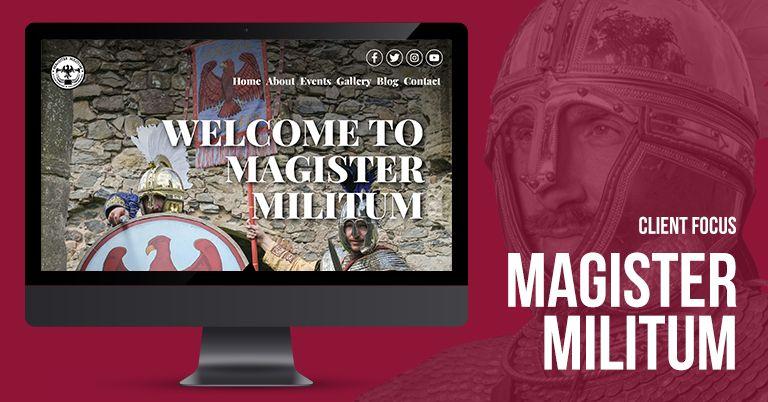Who are Magister Militum
Matthew and Ross came to us with a requirement for a professional website to represent their passion-driven re-enactment interest. They’d managed to purchase a domain name and put a picture on it, but not got much further.
The group themselves focus on recreating battles from early ancient through to the dark ages, specifically regiments of emperor Flavius Claudius.
We’ve designed and built a lot of websites, but this was a bit of a first for us. Not every website can be interesting, many are born of necessity and function, so it was a real change of pace to take on this passion-project. The result is something really original and different from anything else we’ve built.
Website brief
Both Ross and Matthew are extremely passionate about their group, but gave us a huge amount of autonomy to create something highly visual that captures the spirit of what they do. Ross in particular supplied large amounts of well-written copy for the project, which gives the site real substance. This is also backed up by a huge catalogue of photography from previous events. The team consider this to be the ideal scenario; great imagery, strong content and a blank canvas to build something fun and unique.
In terms of functionality, the client needed to be able to publicise their events while also showcasing imagery from their previous re-enactments. The site also required a blog feature, which is a great location for historical pieces, news and updates from the group. Take a look at our in-depth feature on why you should write a blog.
How we did it
We built the site on the Next JS / React frontend framework with the aim to statically generate content for the site when updated. This approach, known as Incremental Static Regeneration (ISR) means that visitors will always browse static / flat pages, these require no database access or building at runtime. This results in a site that’s lightning-fast to visit and excellently positioned for digestion by search engines.
Next JS also has some really handy features “baked in”, one of these being automatic image compression and processing. The group are free to upload their new imagery in standard jpg format, it’ll then be converted on-the-fly to modern web-specific formats like webp, these are far smaller and better suited to the modern web. This is an especially strong feature for this project as it’s so visual. The keen image compression allows us to publish a really image-heavy site without slowing down the viewing experience for visitors.
Behind the scenes, the framework is doing a lot of “heavy lifting” to keep things ticking along at a nice pace. Aside from the image processing, everything is lazy-loaded with blue placeholders – images are only loaded when the visitor scrolls them into view. We didn’t want to compromise the amazingly imagery the client had provided, but obviously there’s always a trade off with image size and loading speed.
Data is drawn from a headless content management system, Strapi in this case. This is often our go-to content management system; it offers a fantastic user interface and neatly separates design from data. The website developer curates the design, all the client needs to do is provide data for the site and the pages are generated automatically.
One of the quirkier features of this site is the timeline-style blog feature we designed. Functionality wise it works like any other blog feature, but has a style and feel which really complements the unique look of the other site design elements.
The whole team enjoyed this project, and we’d consider it to be a stand-out item in our portfolio. It’s a site that often provokes a reaction and something we frequently receive comments on. Not every project can be fun, but this one was! Thanks to Matthew and Ross for choosing us to build their site. You can take a look at the finished article by visiting: https://magister-militum.co.uk/
